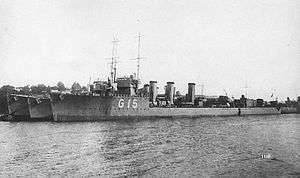HMS Restless (1916)
HMS Restless was an R-class destroyer which served with the Royal Navy during World War I. Launched on 12 August 1916, the ship operated as part of the Grand Fleet, operating as part of a destroyer flotilla protecting convoys in the North Sea. After the War, the destroyer served in the Mediterranean Sea and was sold to be broken up on 23 November 1936.
 R-class destroyers, sistership HMS Romola nearest | |
| History | |
|---|---|
| Name: | HMS Restless |
| Builder: | John Brown & Company, Clydebank |
| Yard number: | 451 |
| Laid down: | 22 September 1915 |
| Launched: | 12 August 1916 |
| Commissioned: | 21 October 1916 |
| Decommissioned: | 23 November 1936 |
| Fate: | Broken up |
| General characteristics | |
| Class and type: | R-class destroyer |
| Displacement: |
|
| Length: | 265 ft (80.8 m) p.p. |
| Beam: | 26 ft 9 in (8.15 m) |
| Draught: | 9 ft 10 in (3.00 m) |
| Propulsion: |
|
| Speed: | 36 knots (41.4 mph; 66.7 km/h) |
| Range: | 3,440 nmi (6,370 km) at 15 kn (28 km/h) |
| Complement: | 82 |
| Armament: |
|
Design and development
Restless was one of seventeen R-class destroyers ordered by the British Admiralty in July 1915 as part of the Sixth War Construction Programme.[1] The destroyer was 265 feet (80.77 m) long between perpendiculars, with a beam of 26 feet 9 inches (8.15 m) and a draught of 9 feet 10 inches (3.00 m).[2] Displacement was 975 long tons (991 t) normal and 1,173 long tons (1,192 t) deep load.[3] Power was provided by three Yarrow boilers feeding two Brown-Curtis geared steam turbines rated at 27,000 shaft horsepower (20,000 kW) and driving two shafts, to give a design speed of 36 knots (67 km/h; 41 mph).[4] Three funnels were fitted. 296 long tons (301 t) of oil were carried, giving a design range of 3,450 nautical miles (6,390 km; 3,970 mi) at 15 knots (28 km/h; 17 mph).[4]
Armament consisted of three 4 in (100 mm) Mk IV QF guns on the ship's centreline, with one on the forecastle, one aft on a raised platform and one between the second and third funnels.[2] A single 2-pounder (40 mm) pom-pom anti-aircraft gun was carried, while torpedo armament consisted of two twin mounts for 21 in (533 mm) torpedoes. [4] Fire control included a single Dumaresq and a Vickers range clock.[5] The ship had a complement of 82 officers and ratings.[2]
Construction and career
Restless was laid down by John Brown & Company at Clydebank on the River Clyde in 22 September 1915 and launched in 12 August 1916, leaving the yard on 21 October that year. The destroyer was allocated the yard number 451.[6] Total build time was 324 days, with 70 days spent at the yard in fit-out.[7]
On commissioning, Restless joined the 15th Destroyer Flotilla of the Grand Fleet and served there until 1919.[8][9] The Flotilla was involved in supporting the convoys that crossed the North Sea, including taking part in anti-submarine patrols between 15 and 24 June 1917. Although sixty-one sightings of submarines and twelve attacks were reported during that operation, no submarines were sunk.[10] On 24 April 1918 the Flotilla was called to intercept the High Seas Fleet on what was to prove the last expedition by the German Navy of the War.[11]
After the War, Restless was stationed in Gibraltar as part of the local defence flotilla.[12] On 23 November 1936, the destroyer was given to Thos W Ward of Sheffield in exchange for RMS Majestic and was subsequently broken up at Briton Ferry.[13]
Pennant numbers
| Pennant Number | Date |
|---|---|
| G88 | 1917[14] |
| G85 | 1918[14] |
References
Citations
- Friedman 2009, p. 310.
- Parkes & Prendegast 1919, p. 107.
- McCaid, John (2011). "Restless 1916 HMS – Destroyer". Clydemarine. Retrieved 6 May 2020.
- Gardiner & Gray 1985, p. 81.
- "Fire Control in H.M. Ships". The Technical History and Index: Alteration in Armaments of H.M. Ships during the War. 3 (23): 31. 1919.
- Johnston 2014, p. 198.
- Johnston 2014, p. 14.
- "Destroyer Flotillas of the Grand Fleet". The Navy List: 13. July 1917. Retrieved 5 May 2020.
- "Destroyer Flotillas of the Grand Fleet". The Navy List: 12. January 1919. Retrieved 5 May 2020.
- Newbolt 1931, pp. 54–56.
- Newbolt 1931, pp. 237–238.
- "VII The Mediterranean". The Navy List: 713. January 1920. Retrieved 5 May 2020.
- Colledge & Warlow 2010, p. 338.
- Dittmar & Colledge 1972, p. 70.
Bibliography
- Colledge, J. J.; Warlow, Ben (2010). Ships of the Royal Navy: The Complete Record of all Fighting Ships of the Royal Navy. Havertown: Casemate. ISBN 978-1-93514-907-1.CS1 maint: ref=harv (link)
- Dittmar, F.J.; Colledge, J.J. (1972). British Warships 1914–1919. Shepperton: Ian Allan. ISBN 978-0-71100-380-4.CS1 maint: ref=harv (link)
- Friedman, Norman (2009). British Destroyers: From Earliest Days to the Second World War. Barnsley: Seaforth Publishing. ISBN 978-1-84832-049-9.CS1 maint: ref=harv (link)
- Gardiner, Robert & Gray, Randal, eds. (1985). Conway's All The World's Fighting Ships 1906–1921. London: Conway Maritime Press. ISBN 978-0-85177-245-5.CS1 maint: ref=harv (link)
- Johnston, Ian (2014). A Shipyard at War: Unseen Photographs of John Brown & Co. Ltd, Clydebank, 1914-18. Barnsley: Seaforth Publishing. ISBN 978-1-84832-216-5.CS1 maint: ref=harv (link)
- Newbolt, Henry (1931). Naval Operations: Vol. V. History of the Great War. London: Longmans, Green and Co.CS1 maint: ref=harv (link)
- Parkes, Oscar; Prendegast, Maurice (1919). Jane’s Fighting Ships. London: Sampson Low, Marston & Co. Ltd.CS1 maint: ref=harv (link)